How To Install Ggplot2 In Rstudio
Install R
Revise how to install R, as previously discussed hither and here.
Installation
How practise yous download and install R? Google "CRAN" and click on the download link, and so follow the instructions (east.yard. at "install R for the kickoff time").
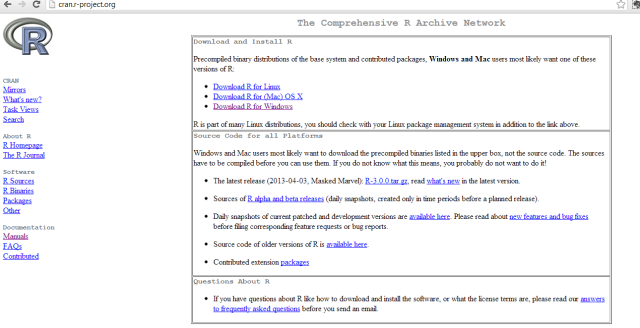
Anthony Damico has produced some neat video tutorials on using R, hither is his how-to guide:
http://www.screenr.com/kzT8
And moonheadsing at Learning Omics has got a blog postal service with a series of screen-shots showing you how to install R with pictures.
Install R-studio
Having installed R, the next thing we volition want to do is install R-studio, a popular and useful interface for writing scripts and using R.
If you google "R-studio" you will get to this window:
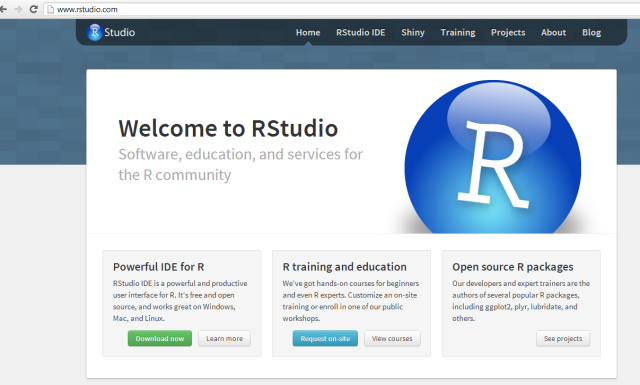
Click on the "Download now" push button and you will run across this window:

Click on the "Download RStudio desktop" and y'all will run into this window:

You tin just click on the link to the installer recommended for your computer.
What happens side by side depends on whether you take administrative/root privileges on your reckoner.
I believe you tin install R-studio without such rights using the nil/tarball dowload.
Having installed R and R-studio, in Windows you will come across these applications now listed every bit newly installed programs at the commencement carte du jour. Depending on what you said in the installation process, y'all might also have icons on your desktop.
Click on the R-studio icon – information technology will pick up the R installation for you.
Now we are ready to get things done in R.
Start a new script in R-studio, install packages, draw a plot
Hither, we are going to 1. start a new script, ii. install and so load a library of functions (ggplot2) and three. use it to draw a plot.
Depending on what you did at installation, you tin can expect to find shortcut links to R (a blueish R) and to R-Studio (a shiny bluish circumvolve with an R) in the Windows start menu, or as icons on the desktop.
To become started, in Windows, double click (left mouse push button) on the R-Studio icon.
Peradventure y'all're now looking at this:
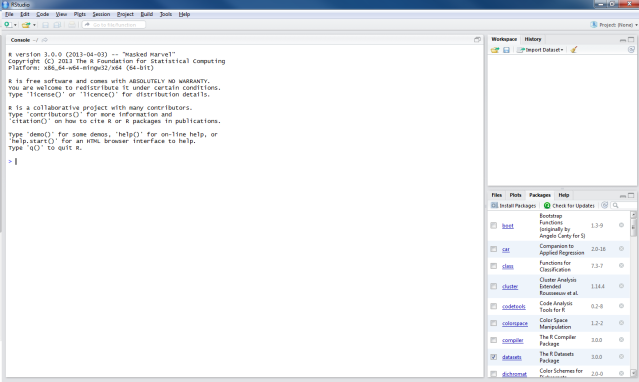
1. Start a new script
What yous volition demand to practise next is go to the file menu [meridian left of R-Studio window] and create a new R script:
–move the cursor to file – then – new – then – R script and then click on the left mouse button
or
— just printing the buttons ctrl-shift-N at the same time — the 2d movement is a keyboard shortcut for the first, I prefer keyboard brusk cuts to mouse moves
— to go this:
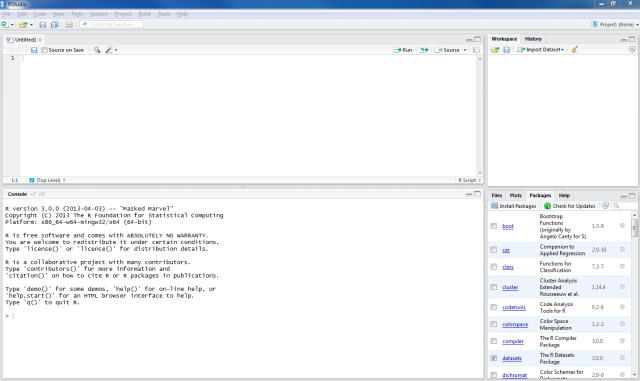
What's side by side?
This circled bit y'all see in the motion-picture show beneath:
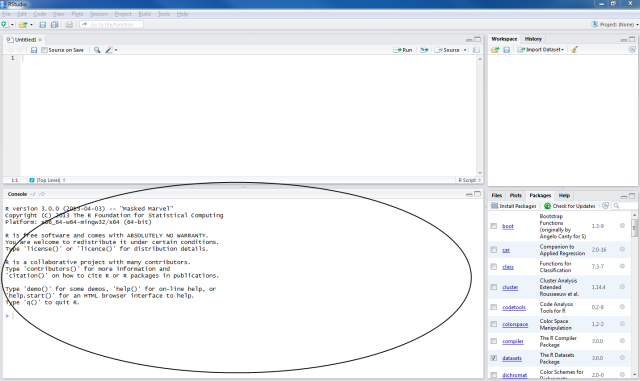
is the panel.
It is what you would see if you open R directly, not using R-Studio.
You can type and execute commands in information technology but mostly yous will see unfolding hither what happens when you write and execute commands in the script window, circled below:
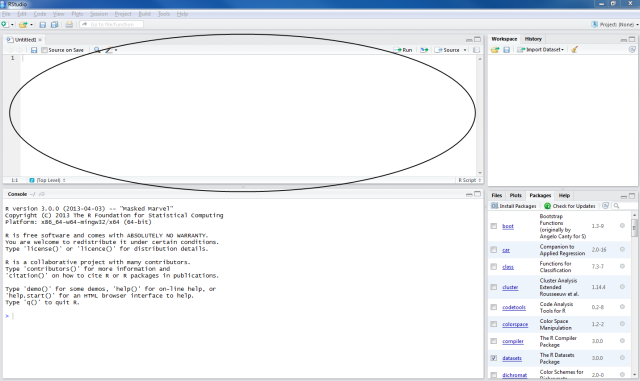
— The panel reflects your deportment in the script window.
If you look on the superlative correct of the R-Studio window, y'all tin see two tabs, Workspace and History: these windows (they can be resized by dragging their edges) likewise reflect what you lot do:
1. Workspace will show you the functions, information files and other objects (e.thousand. plots, models) that you are creating in your R session.
[Workspace — See the R introduction, and see the this helpful post past Quick-R — when yous work with R, your commands outcome in the creation of objects e.g. variables or functions, and during an R session these objects are created and stored past name — the collection of objects currently stored is the workspace.]
two. History shows you the commands you execute equally you execute them.
— I look at the Workspace a lot when using R-Studio, and no longer await at (only did once use) History much.
My script is my history.
ii. Install and then load a library of functions (ggplot2)
We tin can start by adding some capacity to the version of R we have installed. We install packages of functions that we will be using eastward.chiliad. packages for cartoon plots (ggplot2) or for modelling data (lme4).
[Packages – see the introduction and this helpful page in Quick-R — all R functions and (congenital-in) datasets are stored in packages, only when a package is loaded are its contents bachelor]
Copy and then paste the post-obit command into the script window in R-studio:
install.packages("ggplot2", "reshape2", "plyr", "languageR", "lme4", "psych") Highlight the command in the script window …
— to highlight the command, concord down the left mouse button, drag the cursor from the start to the finish of the command
— then either printing the run push button …
[run across the run button on the superlative right of the script window]
… or press the buttons CTRL-enter together, and scout the console bear witness you R installing the packages you have requested.
Those packages will e'er be available to yous, every time you open R-Studio, provided you load them at the showtime of your session.
[I am sure there is a way to ensure they are always loaded at the kickoff of the session and will update this when I observe that out.]
At that place is a ii-infinitesimal version of the foregoing laborious step-past-footstep, by ajdamico, here. N.B. the video is for installing and loading packages using the plain R panel only applies equally to R-Studio.
Having installed the packages, in the same session or in the side by side session, the first affair y'all need to practice is load the packages for use by using the library() role:
library(languageR) library(lme4) library(ggplot2) library(rms) library(plyr) library(reshape2) library(psych)
— re-create/paste or type these commands into the script, highlight and run them: yous will see the console fill up with data nearly how the packages are beingness loaded:
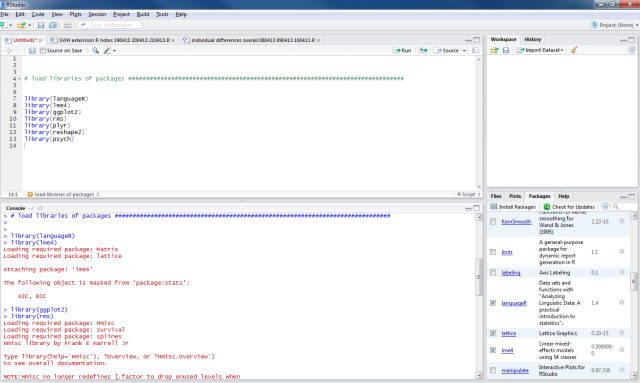
Detect that the packages window on the bottom right of R-Studio now shows the listing of packages have been ticked:
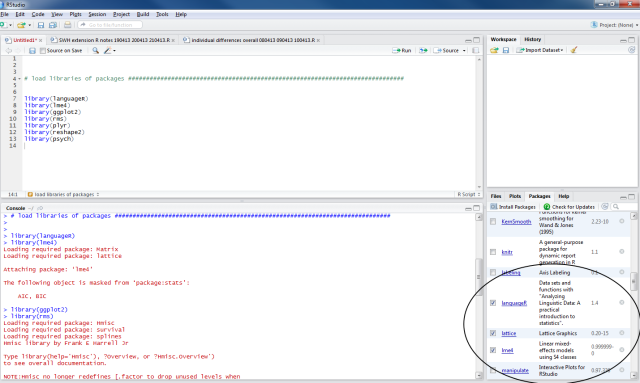
Allow's do something interesting now.
iii. Use ggplot function to describe a plot
[In the following, I will use a simple case from the ggplot2 documentation on geom_point.]
Copy the following 2 lines of code into the script window:
p <- ggplot(mtcars, aes(wt, mpg)) p + geom_point()
— run them and yous will run into this:
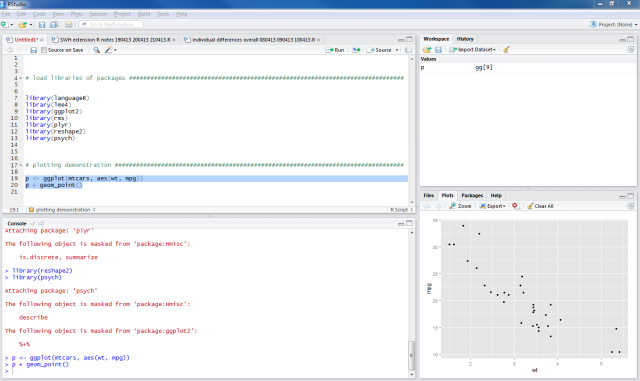
— discover that the plot window, bottom right, shows y'all a scatterplot.
How did this happen?
Wait at the first line of lawmaking:
p <- ggplot(mtcars, aes(wt, mpg))
— information technology creates an object, you can encounter it listed in the workspace (information technology was not there before):
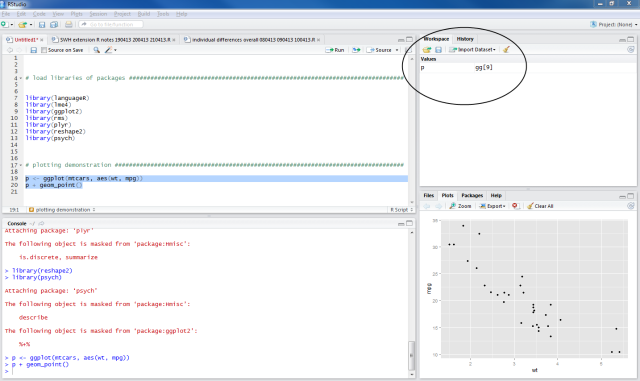
— that line of lawmaking does a number of things, so I will intermission information technology downward slice by piece:
p <- ggplot(mtcars, aes(wt, mpg))
p <- ...
— means: create <- (assignment arrow) an object (named p, now in the workspace)
... ggplot( ... )
— ways practise this using the ggplot() function, which is provided by installing the ggplot2 package then loading (library(ggplot) the ggplot2 package of data and functions
... ggplot(mtcars ...)
— means create the plot using the data in the database (in R: dataframe) called mtcars
— mtcars is a dataframe that gets loaded together with functions like ggplot when you execute: library(ggplot2)
... ggplot( ... aes(wt, mpg))
— aes(wt,mpg) means: map the variables wt and mpg to the aesthetic attributes of the plot.
In the ggplot2 book (Wickham, 2009, due east.g. pp 12-), the things you see in a plot, the colour, size and shape of the points in a scatterplot, for instance, are aesthetic attributes or visual backdrop.
— with aes(wt, mpg) nosotros are informing R(ggplot) that the named variables are the ones to be used to create the plot.
Now, what happens next concerns the nature of the plot nosotros desire to produce: a scatterplot representing how, for the information we are using, values on one variable relate to values on the other.
A scatterplot represents each observation equally a signal, positioned according to the value of two variables. Besides as a horizontal and a vertical position, each indicate also has a size, a colour and a shape. These attributes are called aesthetics , and are the backdrop that can be perceived on the graphic.
(Wickham: ggplot2 volume, p.29; emphasis in text)
— The observations in the mtcars database are information about cars, including weight (wt) and miles per gallon (mpg).
[see
http://127.0.0.i:29609/assistance/library/datasets/html/mtcars.html
in case yous're interested]
— This bit of the lawmaking asked the p object to include two attributes: wt and mpg.
— The aesthetics (aes) of the graphic object will be mapped to these variables.
— Nothing is seen yet, though the object now exists, until you run the next line of code.
The adjacent line of code:
p + geom_point() — adds (+) a layer to the plot, a geometric object: geom
— hither we are request for the addition of geom_point(), a scatterplot of points
— the variables mpg and wt will be mapped to the aesthetics, ten-axis and y-centrality position, of the scatterplot
The wonderful thing nearly the ggplot() function is that nosotros can keep calculation geoms to change the plot.
— add a command to the second line of code to show the relationship between wt and mpg for the cars in the mtcars dataframe:
p <- ggplot(mtcars, aes(wt, mpg)) p + geom_point() + geom_smooth()
— here
+ geom_smooth()
adds a loess smoother to the plot, indicating the predicted miles per gallon (mpg) for cars, given the data in mtcars, given a car'south weight (wt).
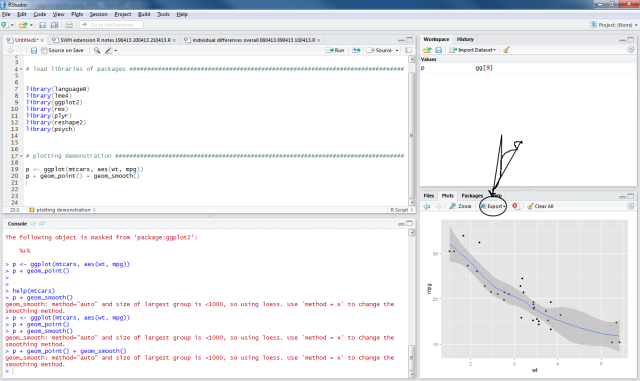
[If yous desire to know what loess means – this post looks similar a good identify to get started.]
Detect that there is an export button on the acme of the plots window pane, click on information technology and export the plot equally a pdf.
Where does that pdf become saved to? Good question.
What have we learnt?
— starting a new script
— installing and loading packages
— creating a new plot
Vocabulary
functions
install.packages()
library()
ggplot()
critical terms
object
workspace
package
scatterplot
loess
aesthetics
Source: https://ayeimanol-r.net/2013/04/21/289/
Posted by: palombohatep1996.blogspot.com


0 Response to "How To Install Ggplot2 In Rstudio"
Post a Comment